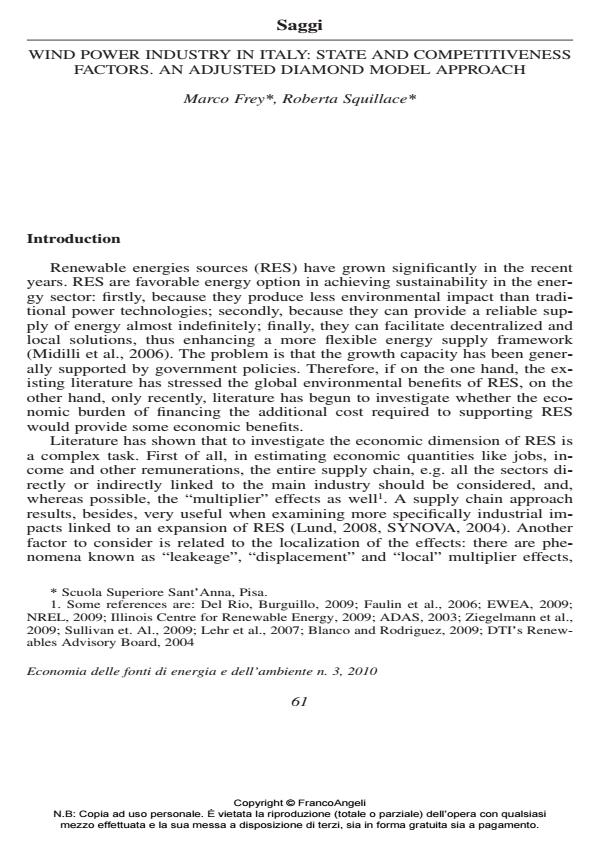L’eolico in Italia: stato del settore e competitività secondo il modello a Diamante di Porter
Journal title ECONOMICS AND POLICY OF ENERGY AND THE ENVIRONMENT
Author/s Marco Frey, Roberta Squillace
Publishing Year 2011 Issue 2010/3
Language English Pages 26 P. 61-86 File size 1956 KB
DOI 10.3280/EFE2010-003005
DOI is like a bar code for intellectual property: to have more infomation
click here
Below, you can see the article first page
If you want to buy this article in PDF format, you can do it, following the instructions to buy download credits

FrancoAngeli is member of Publishers International Linking Association, Inc (PILA), a not-for-profit association which run the CrossRef service enabling links to and from online scholarly content.
Wind energy has grown significantly in the recent years worldwide, as an option in achieving sustainability in the energy sector. In Italy the wind capacity installed has boomed as well, in terms of capacity installed and government incentives given to the sector, achieving the record value od 5,797 MW installed in 2010, positioning itself 6th below countries as China, US, Germany, Spain and India. As a new developing sector, the present paper aims to investigate which are the features of the new emerging industry and which factors are affecting its competitiveness. Moreover, some findings have been used to identify and discuss which are the main weakness and strengths, threats and opportunities of the sector. In order to have an integrated picture of the industry competitiveness, they have been used those categories belonging to the theoretical framework of Porter’s Diamond Model, namely (1) Factor Conditions, (2) Demand Conditions, and (3) Firm’s Strategy, Structure and Rivalry, (4) Related and Support Industry, (5) Government and (6) Chance. The model has been adjusted taking into account some critics and improvements of the original Porter model. Each category has been analysed in details; data that comes from archival documents were reviewed carefully in order to select the more authoritative sources. A crucial part of the study concerns the analysis of technology capability and the firm’s strategy and rivalry and the support industry; arguments have been deepen by using a survey that has involved companies operating along the wind supply chain in Italy. The survey offered the opportunity to have a "firm’s perspective", concerning the perceptions of competitiveness opportunities and barriers by business executives who are dealing with local and global business situations. Moreover a final discussion of the main findings of the competitiveness analysis have been translated in terms of a SWOT analysis, that has the advantage of being easily readable by the industry itself and by decision makers. The main result of the study is that the growth in wind capacity installed in Italy has led to the development a new industry composed of multinational subsidiaries and local companies, operating in different areas of the supply chain has developed. The sector has been characterised by high dynamism and by increasing competitiveness, along the all supply chain that has promoted the development of new companies and new business that have had positive return on income and jobs. Positive advanced factor conditions, like physical resources, the high level of renewable energy demand due to the high fossil fuel dependance of Italy, government policies supporting the domestic market have positively influenced competitiveness of the industry. The main weakness of the industry is that it has still a marginal role in technology production, and R&D activities, which are commonly carried out abroad. However the learning process that has been created has been a stimulus for new turbine and component R&D activities. Therefore, actors and decision makers could attempt to further strengthen positive factors and overcome the negative ones in order to increase competitiveness of the national wind industry.
Keywords: Italy, wind energy industry, competitiveness, SWOT analysis
Jel codes: O13, O32
Marco Frey, Roberta Squillace, Wind power industry in Italy: State and competitiveness factors. An adjusted diamond model approach in "ECONOMICS AND POLICY OF ENERGY AND THE ENVIRONMENT" 3/2010, pp 61-86, DOI: 10.3280/EFE2010-003005